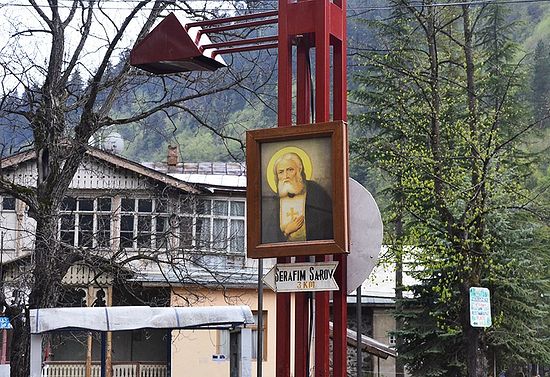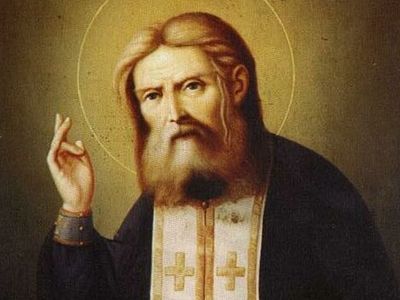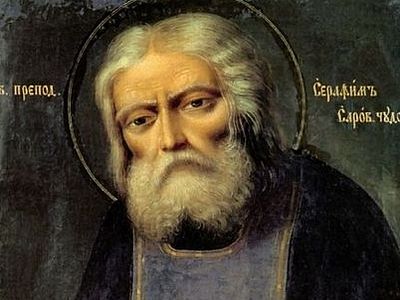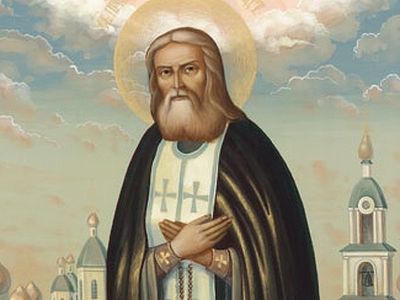 Metropolitan Seraphim (Jojua) of Borjomi and Bakuriani takes a blessing from fresco of St. Seraphim.
Metropolitan Seraphim (Jojua) of Borjomi and Bakuriani takes a blessing from fresco of St. Seraphim.
The most popular Russian saint in Georgia is St. Seraphim of Sarov.
Churches in Borjomi and Dedoplistskaro are dedicated to him.
Icons of this great Russian elder, created by Georgian icon-painters, can be found at any church shop.
If you google “წმ. სერაფიმე საროველი…” (“Seraphim of Sarov” in Georgian), you will find a multitude of pages and will read comments which are full of love. There are many of them, ranking from short ones (for example, “St. Seraphim of Sarov, pray to God for us!”) to testimonies of real miracles.
Visit the page “წმიდა სერაფიმ საროველი საზოგადოება” (“Society of St. Seraphim of Sarov”) on Facebook and you will find an impressive number of “likes”.1
Archpriest Vladimir Kuznetsov relates:
Metropolitan Seraphim (Jojua) with pride showed us his brainchild: New Sarov. Using pictures and photographs, he lovingly recreated Father Seraphim’s hermitage with a small wooden cell and the ‘Tender Feeling’ icon of the Mother of God, with a rock under a canopy, a well, and even a bear in a special open-air cage; although we did not find the bear. It grew very big and ate as much food a day as several of the convent’s nuns could eat. With time the sisters could not feed it any more. They pled with the metropolitan to free them this obedience. But now the nuns are willing to take another bear cub; they feel they really need it. People who visit this place feel a real corner of Russia on this spot. Many of them wish they could travel to Sarov or Diveyevo, but that is beyond their means.
At the small Church of St. Seraphim of Sarov, Metropolitan Seraphim asked a painter to depict him as a paralytic at the saint’s feet. This church was consecrated in 2007. On St. Seraphim’s feast days many of the faithful flock here. The metropolitan himself loves Father Seraphim very much.
The hierarch recalls how before receiving the monastic tonsure the primate of the Georgian Orthodox Church asked him what name he wished to have in monasticism. He said nothing in reply, instead praying to St. Seraphim inwardly. So Patriarch Ilia II said, “Then you will be Seraphim...”2
This is what Metropolitan Seraphim himself relates:
“…The war of 20083 was a tragic mistake. At that time, we in Borjomi were preparing for the arrival of Russian tanks, although our town is situated away from the major highway. I said to the chief police officer: ‘If you see tanks, call me immediately. I will come out and tell them: guys, don’t fire—after all, both we and you are Orthodox!’ And meanwhile I prayed to St. Seraphim of Sarov so that he would save our town from destruction. A tank appeared on the outskirts of Borjomi. It stopped at the entrance to the town. An officer and a soldier leaned out of the tank hatch. ‘We have come to taste your Borjomi [a brand of mineral water from Borjomi]. We have heard much of your spring since childhood,’ the officer said. Imagine! These tankmen made a big detour of thirty kilometers [c. 18.64 miles] in order to drink our healing water! They bathed in the Kura River and turned back. Thus, through the intercessions of St. Seraphim our town did not suffer. For centuries we lived together—Russians, Georgians, Abkhazians; we would sit at the same table, propose toasts to each other, and have fun. Nobody paid attention to each others’ nationalities, yet everything changed so radically just over several years!”4
A film was shot about the church dedicated to St. Seraphim of Sarov in Borjomi.5
It relates that the Church of St. Seraphim of Sarov was built after an elder clothed in white had appeared to a man named Tamaz Kurtanidze three times in a dream, revealing to him not only the location of the future church but also the name of the saint in whose memory it was to be dedicated.
Metropolitan Seraphim gives a detailed account of miracles that occurred after the consecration of the church.
“One local boy heard a sermon on St. Seraphim and appealed to him in his prayer: ‘I have never seen a young deer. Please, show one to me, and I will light a candle before your icon!’ Then he went out of the church. Ten minutes later the lad cried out: ‘Look! Look!’ We all came out on the porch and saw a little deer run out of the wood and then stop near the boy. But, of course, seeing many people, the fawn soon got scared and ran off back into the forest.
“An eleven-year-old paralyzed girl was healed on the rock after a public prayer service.
“There was also another occurrence. Once two women and a six-year-old child came to the church. The ladies started reading an Akathist while the child climbed the stone and began to jump on it. The nuns reprimanded him, saying that the stone was blessed and it was inappropriate to play on it. However, the mother ignored the reproof and continued her reading. Suddenly some invisible force threw the child off the stone; he started vomiting and was seized by convulsions, though up till then he was absolutely healthy.”6
There is also a film about a bear that came to the church of St. Seraphim of Sarov itself.7
Nina Izyumova in her article, Seraphim of Sarov and Georgia, writes:
The veneration of the holy wonderworker of Sarov especially spread in Georgia during the twentieth century. The elder appeared to many people in the most difficult moments of their lives. Largely separated from the Church, most of them even did not know who he was (in those days it was prohibited to mention the saint’s name even in the few existing Church newspapers). It was years later that they first looked at his icon and recognized the elder who had helped them. Georgia felt his prayers and protection.
Only afterwards did it become known that the saint opposed the abolition of the ancient Georgian Church’s autocephaly. But could the masonic court of Emperor Alexander I heed what he said? No, it couldn’t, and didn’t. Furthermore, the elder used to say that as you treat Georgia so you will be treated by the Mother of God. For Georgia is considered to be a country chosen by the Mother of God. In Georgia churches are never locked. If you enter any one of them, whether it be a magnificent cathedral in the center of Tbilisi or a tiny chapel hidden in the mountains, you will find his [St. Seraphim’s] icon without fail.
Not long ago, Blessed Matrona of Moscow appeared to one Georgian nun and bade her to pray to St. Sergius of Radonezh, St. Seraphim of Sarov and to herself for the salvation of Georgia and Russia. And people are praying!8
Here are several more examples of miraculous help from St. Seraphim, recounted by the Georgian journalist Kakhaber Kenkishvili.
Schema-Abbess Fomar (Marjanishvili; 1869-1936) deeply venerated St. Seraphim. Kakhaber Kenkishvili writes:
In 1903, when St. Seraphim of Sarov was canonized, she (then young Abbess Juvenalia at Bodbe Convent) sent one of her sisters to Sarov and charged her to bring her an icon of the newly-glorified saint, blessed on his very relics. The nun soon returned with a simple wooden icon measuring twelve by fifteen centimeters (about 4.72 x 5.9 inches).
At the convent this icon was credited with numerous healing miracles.
The young abbess [Junvenalia] protected her sisters and the convent property as best as she could. Revolutionaries9 sent her letters with threats because of her activity. Once they even attacked her carriage on the way to Tiflis [the official Russian name (1845–1936) for Tbilisi]. They started firing. The abbess clasped the icon of St. Seraphim of Sarov to her bosom and began to pray. Suddenly a Cossack’s mounted patrol appeared on the road and the attackers dispersed. Although a large number of bullets lay on the carriage’s floor, none of them touched the abbess or the sisters.
Because of the imminent danger the Holy Synod decided to transfer Abbess Juvenalia to Moscow.
There she became a close friend of Grand Duchess Elizabeth Feodorovna, the foundress of the Convent of Sts. Martha and Mary. The latter asked Mother Juvenalia to give the wonderworking icon of St. Seraphim of Sarov to Tsarevich Alexei who was a hemophiliac. Although it was very difficult for Abbess Juvenalia to part with her relic, she could not turn down the grand duchess’s request.
It is known that the icon hung in the bedroom of the heir to the throne. But its fate after 1917 is sadly unknown…
One day when the abbess was praying before an icon of the Mother of God she felt that God was calling her to become a recluse. The unusual phenomenon before the icon repeated several times.
In order to protect herself from possible demonic delusion, Abbess Juvenalia appealed to spiritual elders. Soon, with their blessing, a skete (hermitage) for women in honor of St. Seraphim of Sarov and the icon of the Mother of God “Of the Sign” was opened, and the abbess was tonsured into the schema with the name Fomar. The skete existed for twelve years and was famous for its very strict rule.
In 1924 the hermitage was closed…10
In 1944, Bishop Ephraim (Sidamonidze; future Catholicos-Patriarch Ephraim II from 1960 till 1972) was released from prison.
Bishop Ephraim, released from escort, was very slowly walking to his motherland. (In jail he had endured such severe hunger that he could hardly walk and could not eat bread for long time). Another released man was following him. Thus they reached a big river. They were about to cross it on a ferryboat, but the ferryman would not let them aboard: “All aboard!” he shouted.
No matter how much they pleaded with him, it was all in vain. So the two men stayed ashore and waited for the next passage within a week. But they waited for nothing. As it turned out, the ferry was bombed by the German forces en route…
The bishop gave praise unto God for saving their lives. Later he recalled: “All the time I thought: What saint was protecting me in the strange land? And I promised myself that on reaching home I would enter my church on my knees and the first saint whose image I would see inside would be my patron.”
This is what he did after his return. And the first thing that he saw inside the church was an icon of St. Seraphim of Sarov.11
Guram Chitanava relates:
“My wife had an uncle whom she loved dearly. And he had a wife whom we called aunt Grunya [a spoken form of the name Agrippina]. She hailed from Penza. During the war she ended up at a collective farm in the Kaspiysk district (northeast Caucasus). She came to Georgia for bread. Then she contracted some disease and when her health was restored she remained in Georgia. She married and gave birth to a daughter, Svetlana. In the 1960s the family moved to Tbilisi.
“Svetlana was in the eighth grade when her appendix suddenly burst. She was urgently taken to Aramyants Hospital.12 Soon her mother was called and told: ‘Take your daughter home. She will die soon.’ Grunya ran to the Church of St. Alexander Nevsky. It was seven in the morning. The woman who sold candles had just unlocked the door. Grunya instantly knelt before the Pochaev icon of the Mother of God. It hung to the right of the entrance. Suddenly someone entered the church and came up to her. She automatically turned round. A monk in a black cassock was standing near her.
“‘Your daughter is well!’ he said. ‘Who are you?’ Grunya asked. ‘I am Father Seraphim. I am on my way to Kiev.’
“Grunya thought to herself: how can he be going to Kiev? On foot? The monk reached into his cassock at his chest and gave Grunya a small icon of the Kazan Mother of God. While Grunya was putting the icon into her bag, the monk vanished. She then came up to the woman selling candles and asked her who he was. The latter answered: ‘No one has entered the church.’
Grunya hastened to the hospital. When she got there she saw her daughter sitting on bed, absolutely healthy. ‘Mama, where have you been all this time?’ she asked.
“They decided to have a good look at the icon and found that there was a particle of the relics of St. Seraphim of Sarov on its reverse side.
“In the 1980s, when Grunya died, that icon was kept in a conspicuous place. The coffin was photographed during the funeral, and when the negatives were developed, they saw a bright light coming out of the icon.
“Later Grunya’s grandson took this icon with him to the war in Abkhazia (1992-1993) and returned safely from it…”
***
“‘What is your brother’s name?’ I asked Elena Razmadze.
‘He was baptized with the name Seraphim as he was born on August 2. His parents had no other names in mind.’”
Valentina Marjanishvili relates:
“Last year I sprained my ankle badly in Borjomi. It was in the morning. My leg hurt terribly. And on that evening I planned to travel by funicular to the top of a mountain and visit the convent where one Georgian family from Borjomi had recreated a corner with a hut, a well and a rock, in imitation of Diveyevo, where St. Seraphim of Sarov lived as a hermit. Though lame, I nevertheless journeyed to Father Seraphim. He is my heavenly patron. I knelt down by the rock. There was a young couple nearby. The man was reading prayers in Georgian. I absorbed myself into this blissful atmosphere. After that I returned home with no more than a slight reminder of the former pain.”
Marina Uchaneishvili relates:
“It was in the 1990s. I went to see a dentist and he extracted my tooth, which had caused a problem. I followed all the doctor’s prescriptions, but towards evening the sore in my mouth started bleeding. The situation was becoming more aggravated. A real hemorrhage began. I panicked. By three in the morning my father drove me to the hospital. A surgeon examined my sores and resolved to put in stitches. ‘If we don’t do it, you may die of loss of blood. The bone can already be seen,’ he said. Whether the doctor seemed too harsh to me or I simply got frightened, I jumped up and refused the operation. Both my dad and the surgeon implored me not to refuse, but I went back home. At home, my mom saw me and got scared. The bleeding was becoming more and more intense. My mother told me: ‘But you believe in God. You can be healed if you pray.’ I asked her to bring me icons of Greatmartyr Panteleimon, Greatmartyr Marina (my patron-saint), and St. Seraphim of Sarov from our icon corner. I pressed them to my breast, but for some reason I started praying to St. Seraphim with a particular zeal. The first thing that I felt was extraordinary warmth and love, overwhelming me. Tears began to stream from my eyes. My soul had never been so filled and my heart had never felt such comfort before. I heard my mom reading ‘the Mother’s Prayer’ and was speechless with fear. At the same time I felt that the bleeding inside my mouth had stopped and the bowl for spitting was not needed any more.
“This happened at five o’clock in the morning. I slept so sweetly, as never before. I woke up just before noon. And I discovered that my sore had completely healed. My mother was amazed and recounted this story to all our friends: ‘People, you can’t imagine how St. Seraphim of Sarov has miraculously helped us!’”
Comments taken from Georgian forums
Marta:
I would like to tell you about a miracle that St. Seraphim of Sarov worked very recently.
Ulcers suddenly developed on the legs of one parishioner of St. George’s Church in Kutaisi. The woman received medical advice more than once, but doctors were unable to help her. So she read daily the Akathist to St. Seraphim while standing at home and lit candles as soon as the aches returned.
Once she resolved to walk to a church dedicated to this saint. As she walked she incessantly invoked the name of this great elder. All of a sudden a jeep braked near her. The driver asked her how he could get to the church. The woman answered, “I am also headed there!” The driver offered her a lift and she got in the car. As they were travelling, the jeep driver explained that he had come to Tbilisi from Russia and now he was looking for a woman in Kutaisi to whom he was supposed to give some ointment from some nuns, and he did not want to go back without keeping his promise. “What is the name of the woman you are looking for?” the parishioner asked. Then the driver uttered her very name and surname! “I was really shocked,” the lady recalled afterwards, astounded by the way St. Seraphim had answered her petitions. The ointment helped, and the ulcers on her legs were healed.
Diana:
My greetings to the Georgian people and all Orthodox Christians on the feast of St. Seraphim of Sarov! My child was in the hospital and I dreamed of obtaining an icon of this saint somewhere. An elderly novice whose son was a monk came to visit a patient in the same hospital. We got to know each other, she opened her bag and held out an icon of St. Seraphim of Sarov to me. My joy was boundless! I was so deeply impressed, as if the elder himself had come to me! Then we went abroad. I took that image and several other icons with me. When my child recovered from a grave illness, I could not find that icon anywhere, while the rest of the icons were in their places. I was very frustrated because of the loss and had no idea how this could have happened, since every day after the evening prayers I reverently kissed all the icons. Later one psalm reader gave me the very same icon of St. Seraphim of Sarov. You will be surprised as to why I did not buy it. For some years my family and I had to live abroad, so every single icon that I was given was of paramount importance to me. Icons were simply unavailable there. I also want to thank the patriarch, who gave us an opportunity to listen to a service in Georgian when we were living far from our motherland. May the merciful love of St. Seraphim of Sarov always be with us!
 This is how the translation of “The Testament” into Georgian looks. It has many “likes” on the internet.
This is how the translation of “The Testament” into Georgian looks. It has many “likes” on the internet.
Drink water from the spring where the horse drinks. A
horse will never drink bad water.
Make your bed where the cat sleeps.
Eat the fruit that was touched by the worm.
Freely pick the mushrooms on which the insects sit.
Plant your tree where the mole digs.
Build your house where the snake suns itself.
Dig your well where the birds build their nests in hot
weather.
Go to sleep and wake up with the chickens and you will
reap the golden grain of the day.
Eat more green vegetables, and you will have strong legs
and an enduring heart.
Swim more often and you will feel on land like a fish in
the water.
Look at the skies more often and not at your feet, and
your thoughts will be clear and light.
Keep silent more often, speak less, and silence will reign
in your soul, and your spirit will be calm and
peaceful.”
May God always help us be so like-minded.











